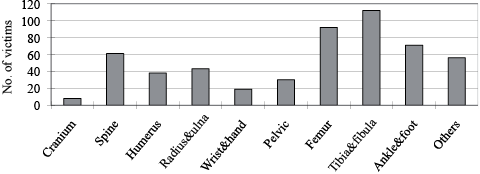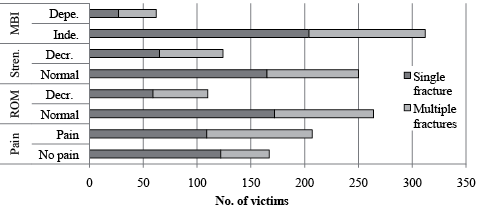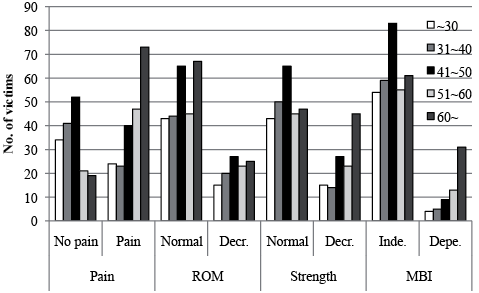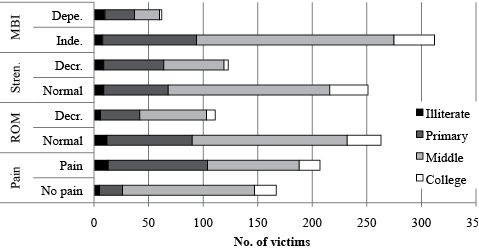Qiang Gao, MMed1,2,3, Aaron Leung, PhD2,3, Qiu Liang, MSc1, Xiaotian Yang, MSc1, Cheng Li, MSc1, Lin Yang, MMed1,2 and Chengqi He, MD1,2
From the 1Department of Rehabilitation Medicine, West China Hospital, Sichuan University, 2Institute for Disaster Management and Reconstruction, Sichuan University – Hong Kong Polytechnic University, Chengdu, Sichuan, China and 3Interdisciplinary Division of Biomedical Engineering, The Hong Kong Polytechnic University, Hong Kong
OBJECTIVE: To investigate the functional status of fracture victims 4 years after the 2008 Wenchuan earthquake.
METHODS: A total of 374 fracture victims who were admitted to the rehabilitation department of 5 municipal hospitals in the hardest hit areas in 2008 were interviewed face to face in 2012. Functional assessments, including muscle strength, range of motion, pain, activities of daily living and working status, were conducted.
RESULTS: Approximately one-third (33.2%) of the fracture victims had decreased muscle strength and 29.4% had limited range of motion. Among the 55.3% of subjects who still experienced pain, the proportions of mild, moderate and severe pain were 65.7%, 28.5% and 5.8%, respectively. The majority (83.4%) of fracture victims were independent in caring for themselves. However, 1.6% of subjects were highly dependent or totally dependent. Single-fracture victims had better muscle strength, range of motion, pain and independence than those with multiple fractures. The degrees of pain, muscle strength and dependency were worse in the older age group, and better in those with a higher level of education. In addition 17.1% were jobless and 22.2% received economic support mainly from family members. The mean unemployment rate was significantly higher and the annual household income (USD 3,086 (standard deviation 1,985) was lower than in the general population in rural Sichuan province.
CONCLUSION: The prevalence of functional disorders, including pain, limited range of motion, decreased muscle strength and dependency in activities of daily living, remained high among fracture victims 4 years after the Wenchuan earthquake. Unemployment rate was high and annual household income was low in this population.
Key words: earthquake; rehabilitation; function; pain; activities of daily living; working status; fracture.
J Rehabil Med 2014; 46: 289–293
Correspondence address: Chengqi He, Department of Rehabilitation Medicine, West China Hospital, Sichuan University, Chengdu 610041, Sichuan Province, China. E-mail: hxkfhcq @126.com
Accepted Jan 8, 2014; Epub ahead of print Mar 13, 2014
Introduction
The magnitude 8.0 earthquake that struck Wenchuan, Sichuan, China, on 12 May 2008 resulted in 69,227 deaths, 374,643 people injured and 17,824 missing, according to a report published by the Chinese Ministry of Civil Affairs (1). Immediately after the earthquake, the Chinese government sent a large number of medical teams to the earthquake-stricken areas to provide emergency relief for the injured victims. A total of 139,642 Chinese healthcare workers participated in the earthquake relief work, 91,298 of them reaching the disaster areas (2). In addition 11 foreign healthcare teams, with a total of 304 workers, participated in the rescue in the first month after the earthquake (3). The total number of hospitalized injuries in Sichuan reached 89,994 within 30 days after the earthquake. There were 16,449 people with severe injuries (4), such as bone fracture, traumatic brain injury, spinal cord injury (SCI), amputation and peripheral nerve injury. It was reported that bone fractures were a contributory factor in more than 46.5% of the injured population (5, 6).
The Chinese government, non-governmental organizations and professional associations sent groups of rehabilitation workers to the heavily hit areas to provide emergency and rehabilitation treatment to the injured earthquake victims (7). The Rehabilitation Medicine Department of the West China Hospital of Sichuan University offered a series of courses on rehabilitation to more than 6,000 occasions in order to enhance the knowledge and skills of the local rehabilitation workers for rehabilitation of the earthquake victims (8). Up to 5 February 2009, 28,008 victims received rehabilitation treatment. Among these cases, there were 16,440 fracture injuries, accounting for 58.7% of these victims (9).
The goal of rehabilitation is to enable patients to return to their homes and society. The short-term functional status or functional recovery of earthquake injuries, including fractures (10), traumatic brain injury (11), peripheral nerve injury (12), amputation (13), or integrated cases (14, 15), were studied in the Wenchuan earthquake. However, reports on the long-term functional status and participation of these patients are very limited. The present study investigated the basic functions, activities of daily living (ADL), working status and family income of the victims with bone fractures 4 years after the Wenchuan earthquake.
Methods
Design
An epidemiological cross-sectional study was conducted in the period February to May 2012. Five municipal hospitals in the 10 areas hardest hit by the Wenchuan earthquake, as identified by the Chinese Ministry of Health, were randomly selected for investigation. Five hundred victims who had fracture injuries and received rehabilitation treatment in the rehabilitation departments of the 5 hospitals during the period 12 May 2008 to 12 May 2009 were studied.
All victims were interviewed face-to-face and assessed by specially trained rehabilitation physicians and rehabilitation therapists.
Instruments
A questionnaire was designed to assess all the fracture victims. Muscle strength and range of motion (ROM) around the fracture sites were evaluated. Manual muscle testing (16) was performed to measure the muscle strength of the tested parts against gravity or resistance from the examiners. ROM was assessed with goniometric method (17) using a full-circle goniometer. The goniometer was placed over the axis of the joint, then the desired direction of the joint was passively placed maximally and the angle between the stationary arm and movable arm of the goniometer was recorded. Pain in the fracture site during daily activities was rated on a visual analogue scale (VAS), with a score of 0 for no pain, 1–4 for mild pain, 5–6 for moderate pain, and 7–10 for severe pain (18). ADL abilities were measured by the Modified Barthel Index (MBI), which reflects the subject’s abilities in self-care in the basic functions of personal hygiene, bowel and bladder control, bathing self, feeding, toileting, dressing, stair climbing and ambulation. MBI score ranges from 0 to 100. The dependency level was classified as total (0–24), severe (25–49), moderate (50–74), mild (75–89) or minimal (90–99) (19, 20). The study protocol was approved by the ethics committee of Sichuan University, China.
Statistical analysis
SPSS 15.0 was used to perform statistical tests. Pain, strength, ROM and MBI in different fracture sites, age groups and education levels were analysed with a χ2 test and Pearson’s coefficient of correlation. Employment and income data were cross-tabulated with gender and education by χ2 test. The employment rate of the fracture victims and the general population in Sichuan province was compared by χ2 test. Annual household income was compared by one-sample t-test. Statistically significant differences were defined by p < 0.05.
Results
Demographics
During the investigation, 126 victims were omitted because they could not be contacted (94), their address had changed (20), they refused to be interviewed (3) or they had died (9). A final total of 374 (180 males and 194 females) fracture victims were interviewed, mean age 48.6 years (standard deviation (SD) 17.2 years). The demographic data are shown in Table I.
|
Table I. Characteristics of the victims (n = 374) |
|
|
Demographics |
n (%) |
|
Age |
|
|
≤ 30 years |
58 (15.5) |
|
31–40 years |
64 (17.1) |
|
41–50 years |
92 (24.6) |
|
51–60 years |
68 (18.2) |
|
> 60 years |
92 (24.6) |
|
Gender, % |
|
|
Male |
180 (48) |
|
Female |
194 (52) |
|
Marital status, % |
|
|
Unmarried |
43 (11.5) |
|
Married |
308 (82.1) |
|
Divorced |
2 (0.5) |
|
Widowed |
21 (5.6) |
|
Education status, % |
|
|
Illiterate |
18 (4.8) |
|
Literate |
356 (95.3) |
|
Primary school |
112 (30.0) |
|
Middle school |
205 (54.5) |
|
College or above |
39 (10.4) |
There was a total of 530 fracture sites as some victims had complex fractures. A summary of the fracture locations is shown in Fig. 1. The most common fracture site was the tibia- fibula (21.1%), followed by the femur (17.4%), the ankle-foot complex (13.4%), and the spine (11.5%). Unusual fracture sites, including collarbone, rib, patella and scapula, accounted for 17% of all fractures.

Fig. 1. Locations of fractures.
Functional status and self management
There were 124 victims (33.2%) with decreased muscle strength; and 110 victims with limited ROM (29.4%). Among the 207 (55.3%) victims who still had pain, the distribution of mild, moderate and severe pain was 136 (65.7%), 59 (28.5%) and 12 (5.8%), respectively. The mean VAS score was 1.67. Results of the MBI showed that 312 victims (83.4%) were independent in caring for themselves. However, 48 victims (12.8%) still needed minimal or mild assistance, and 8 victims (2.1%) needed moderate assistance in their daily lives. Notably, 6 victims (1.6%) were highly dependent or totally dependent.
Victims with multiple fracture sites had significantly increased incidence of pain (χ2 = 16.28, p < 0.01), limited ROM (χ2 = 4.36, p < 0.05), weakness (χ2 = 6.46, p < 0.05) and dependency (χ2 = 10.44, p < 0.01) (Fig. 2). All age groups had significant differences in pain (χ2 = 46.24, p < 0.01), strength (χ2 = 15.99, p < 0.01) and MBI (χ2 = 30.37, p < 0.01) (Fig. 3); pain, weakness and dependency became worse as age increased (for all the Pearson’s R, p < 0.01). At various education levels there were significant differences in pain (χ2 = 50.31, p < 0.01), strength (χ2 = 26.71, p < 0.01) and dependency (χ2 = 31.99, p < 0.01); pain, weakness and dependency decreased with increased education level (for all the Pearson’s R, p < 0.01) (Fig. 4).

Fig. 2. Distribution of functional disorders by single or multiple fracture sites. ROM: range of motion; MBI: Modified Barthel Index; Depe: dependent; Inde: independent; Decr: decreased.

Fig. 3. Distribution of functional disorders by age group. ROM: range of motion; MBI: Modified Barthel Index; Decr: decreased; Inde: independent; Depe: dependent.

Fig. 4. Distribution of functional disorders by educational level. ROM: range of motion; MBI: Modified Barthel Index; Depe: dependent; Inde: independent; Decr: decreased.
Participation
Among the 281 people under the age of 60 years, 185 (65.8%) worked in farming at home or were in full-time employment. Twenty-four people (8.5%) were in part-time employment. Forty-eight people (17.1%) were unemployed, and 24 (8.5%) were studying at school. For 220 people (58.8%) their main source of income was from their work. Twenty-four (6.4%) relied mainly on social insurance or government relief, and 83 (22.2%) were supported mainly by family members (Table II). The unemployment rate was higher than that of the general population (GP) in Sichuan province (21) (p < 0.05) (Table III).
|
Table II. Working status of the victims (n = 374) |
|
|
Variables |
n (%) |
|
Working status, below 60 years |
|
|
Farming or full-time job |
185 (65.8) |
|
Part-time job |
24 (8.5) |
|
Jobless |
48 (17.1) |
|
Study |
24 (8.5) |
|
Source of income |
|
|
Working |
220 (58.8) |
|
Security or insurance |
24 (6.4) |
|
Supported by family |
83 (22.2) |
|
Others |
47 (12.6) |
|
Table III. Unemployment rate and household income compared with general population in rural Sichuan |
||
|
Fracture victims |
Rural Sichuan |
|
|
Unemployment rate, % |
17.1a |
4.1 |
|
Annual household income, USD mean (SD) |
3,086 (1,985)a |
3,691 |
|
aCompared with general population in rural Sichuan, p < 0.01. SD: standard deviation. |
||
As shown in Table IV, 94 (25.1%) people had a family income of less than 12,000 RMB (approximately 1,765 USD). The income of 121 families (32.4%) was between USD 1,766 and 3,530. A total of 103 families (27.5%) earned between USD 3,531 and 8,824. Only 56 families (15.0%) earned more than USD 8,825. Although the income of females was lower than that of males, the difference was not significant (χ2 = 7.13, p = 0.07). Income was significantly different between literate and illiterate subjects (χ2 = 17.21, p < 0.01). The mean annual household income was USD 3,086 (SD 1,985). This was significantly lower than the general population in rural Sichuan province (21) as reported by the Sichuan government in 2012 (p < 0.01) (Table III).
|
Table IV. Annual household income |
||||||
|
Annual household income, USD |
Gender |
Education |
Total n (%) |
|||
|
Male n |
Female n |
Literate n |
Illiterate n |
|||
|
≤ 1,765 |
40 |
54 |
83 |
11 |
94 (25.1) |
|
|
1,766–3,530 |
51 |
70 |
118 |
3 |
121 (32.4) |
|
|
3,531–8,824 |
56 |
47 |
102 |
1 |
103 (27.5) |
|
|
≥ 8,825 |
33 |
23 |
55 |
1 |
56 (15.0) |
|
Discussion
The results of this study show that the most common fracture sites were in the lower extremities. This was consistent with other reports (5). Zhang et al. (22) investigated the fracture victims in the acute stage and found that the rates of muscle strength decrease and ROM limitation were 23.5% and 82%, respectively. Our study showed that the decrease in muscle strength was 33% and the rate of ROM limitation was 29%. Compared with the initial stage, the percentage of weakness was higher and ROM limitation was lower 4 years after the earthquake. These results indicated that ROM was improved after the rehabilitation interventions and return to daily life, while muscle weakness was not effectively prevented after fractures.
Angeletti et al. (23) reported that more than one-third of victims reported pain, and more than half reported severe pain (58.8%) 5 weeks after the earthquake. Zhang et al. (24) conducted a survey of the earthquake victims with fracture 27 months after the earthquake, and found that the mean VAS scores of victims with early and late rehabilitation interventions were 3.82 and 4.02, respectively. Our results showed that 55.3% of the victims still had pain and 5.8% had severe pain; however, the VAS score was 1.67 in our study. These data demonstrated that the pain rate remained high, but the intensity was lower 4 years after the earthquake. Pain is a long-term disturbance in victims with fracture.
ADL is a topical issue in earthquake investigation. Ardalan et al. (25) reported that both the ADL and instrumental activities of daily living capacity of the elderly earthquake survivors decreased over a period of 2 months after the earthquake and that there was no improvement after 5 years. Zhang et al. (24) showed that 27 months after the earthquake the mean MBI score of the victims who had undergone rehabilitation interventions in the early stage of the injury was 92.24. Our results showed that 84% of the fracture victims were totally independent. However, 1.6% of them still needed maximal assistance or were completely dependent.
Investigation of the working status of earthquake victims is rare. In our study, 66% of the victims were in full-time employment. This was much higher than the 15.4% employment rate of the SCI victims of the Wenchuan earthquake (26). The mean household income of USD 3,086 (SD 1,985) was much higher than that of SCI victims (USD 849 (SD 503)) 1 year after the earthquake (26). These differences might be caused by variations in impairments, disabilities and handicaps between victims with fracture and SCI. Immature labour market integration for people with SCI, buildings not adopted for wheelchair users, and lack of vocational rehabilitation may also be crucial factors in this difference. Unemployment rate was significantly higher, and annual household income was significantly lower than the general population in Sichuan province. The working status and income of the fracture victims is a cause for concern.
Study limitations
This study was the first to describe the impairments, ADL and working status of fracture victims 4 years after the Wenchuan earthquake. Some limitations must be considered. Firstly, this study investigated only those fracture victims who had undergone rehabilitation intervention in the local hospitals. Secondly, one-fifth of victims could not be contacted, as they had moved out of the towns and villages destroyed by the earthquake. Thirdly, since there was a lack of functional assessment data at admission and discharge, the follow-up data could not be compared. Routine functional assessment of victims at admission and discharge is therefore recommended.
Conclusion
The prevalence of functional disorders, including pain, limited range of motion, decreased muscle strength and dependency in ADL, remained high among fracture victims 4 years after the Wenchuan earthquake. The unemployment rate was high and annual household income was low in this population. More attention should be paid to these issues in the holistic rehabilitation of earthquake victims.
Acknowledgement
This study was supported by China Medical Board (grant number 08-928).
References
